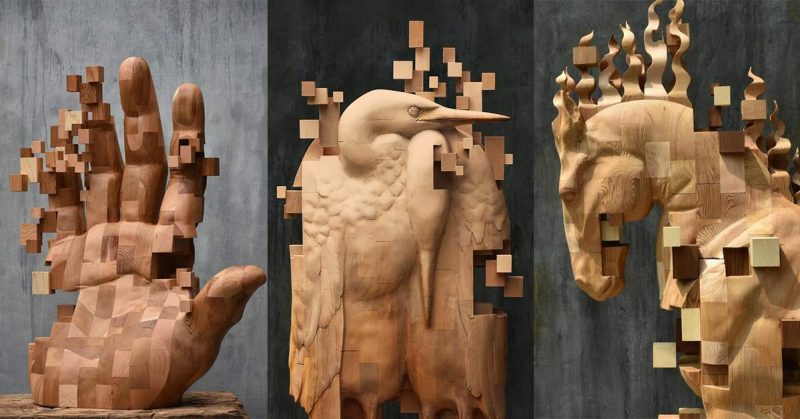If you think nothing unique can come out of wood carving because it’s just wood, then you need to see this.
It’s more than just woodwork
Taiwanese artist Hsu Tung Han has carved out an incredible niche in the field of wood carving. He has successfully come up with a way of blending the old and new. Han employs traditional methods of wood carving to create contemporary sculptures.
Sculptures that look like pixelated glitches
When you think glitches, you think ‘error’. However, that is the very basis of Han’s work. He creates futuristic work from wood by adding pixelated glitches — also with wood — to them. He achieves this look by carefully carving some block pieces into the sculpture so they protrude while others sink in.
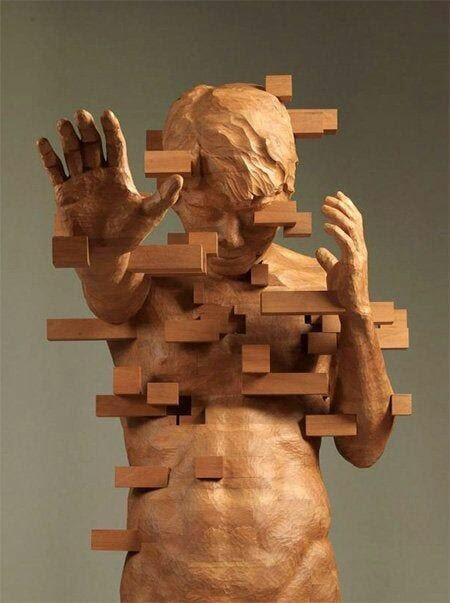
How exactly is Han able to achieve his signature ‘glitched’ looks?
First, he plans them, then he builds a clay model of the sculptures. At this point, he begins to sculpt the wood, most often from walnut, teak, or African wax wood. He treats each piece like a puzzle so that at the end of his work, they appear as if they are a collection of pixels that defy gravity.
This artist carves delicate blocks out of various parts of his sculptures. With that, he can create a semblance of pixelation in three dimensions. Each work never appears fully formed at first glance; further observation will show you that it is quite perfect the way it is. Han works very hard to build dynamic structures that seem to be in motion. [1]
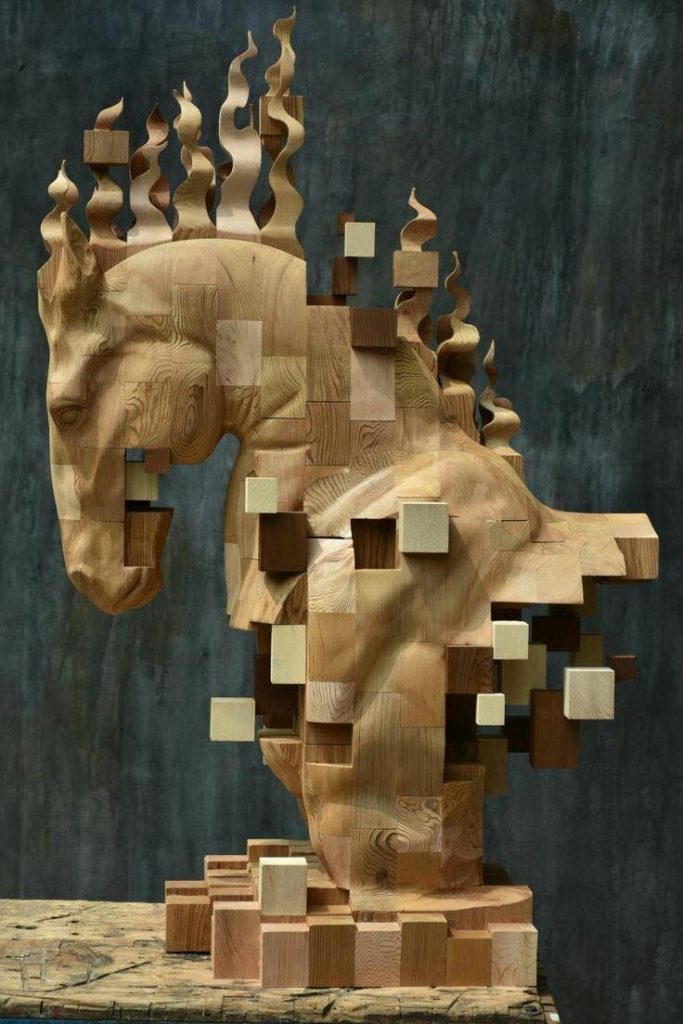
A single block out of place is enough to change the sculpture from a masterfully created illusion to just a distorted work. Therefore, Han does a lot of troubleshooting in an attempt to create the perfect look. But at the end of the day, the labor is well worth it. [2]
Pixels
Pixels are essentially “picture elements.” They are the smallest unit of information that makes up a picture. Most often they are square-shaped and arranged in a two-dimensional grid. You would have to magnify an image several times to see the composition of pixels in each one. Also, the more pixels are in a photo, the more it resembles the original. [3]
While pixels sound like a good thing, they can become an issue when they begin to pop up on your screen in the form of glitches. On most tech forums, people ask questions or complain about “weird graphical glitches and pixels showing up on their screens.”
Which begs the question of why this artist chooses to highlight them instead of bury them.
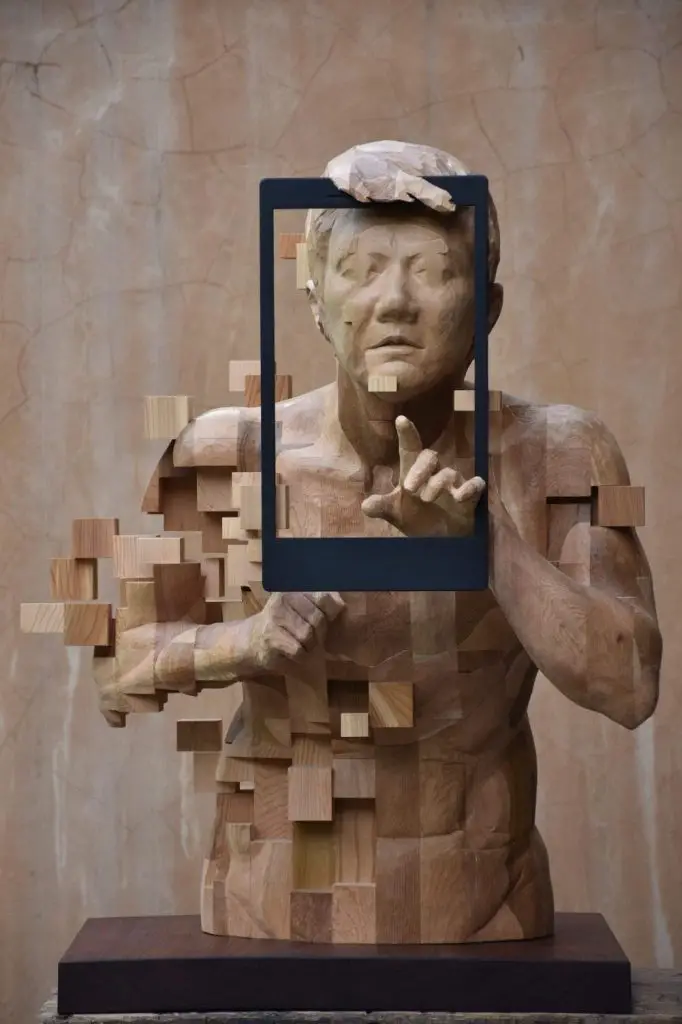
What is the significance of Han’s work?
Is it just the not-so-simple matter of adding and eliminating blocks of wood to create the look of monochromatic arrangement of pixels? It’s a lot more complicated than that. Han’s work speaks to our relationship with the screen.
He strives and, dare I say, succeeds to present the way people are often distracted with their view of the world. Nowadays, more than just bad screens appear distorted and this is something the artist depicts. [4]
Some of Han’s work
Since 2006 when the artist began uploading his work on the internet, he has showcased incredible sculptures that seem to get more intricate and complex yet well-blended.
For instance, there is his “Baseball catcher” who can only be described as a masterpiece. The detail on the work is incredible, from his uniform to his equipment. Every block is placed perfectly; the pixels themselves blend right in with the work in a manner that makes it seem as if the player is in actual motion.
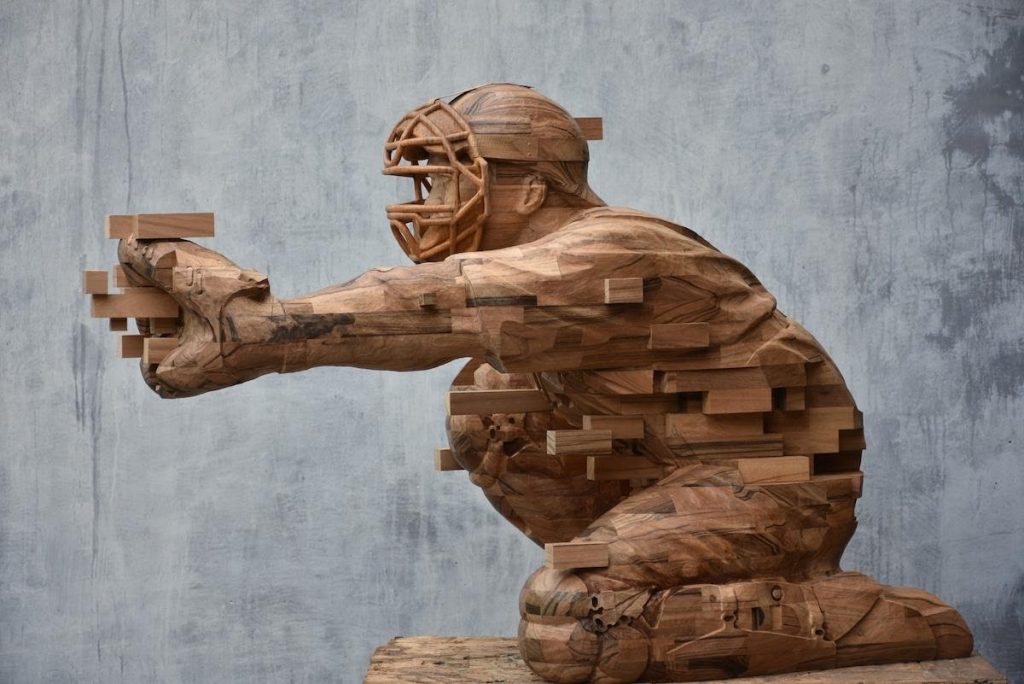
Then there is a sculpture of a snorkeler. So, not only is this artist able to create ‘glitches’, he is also able to give a submerged look to them. Han used the pixels differently this time to make the ‘bubbling water’ that flows around the man as he breathes out of his snorkel.
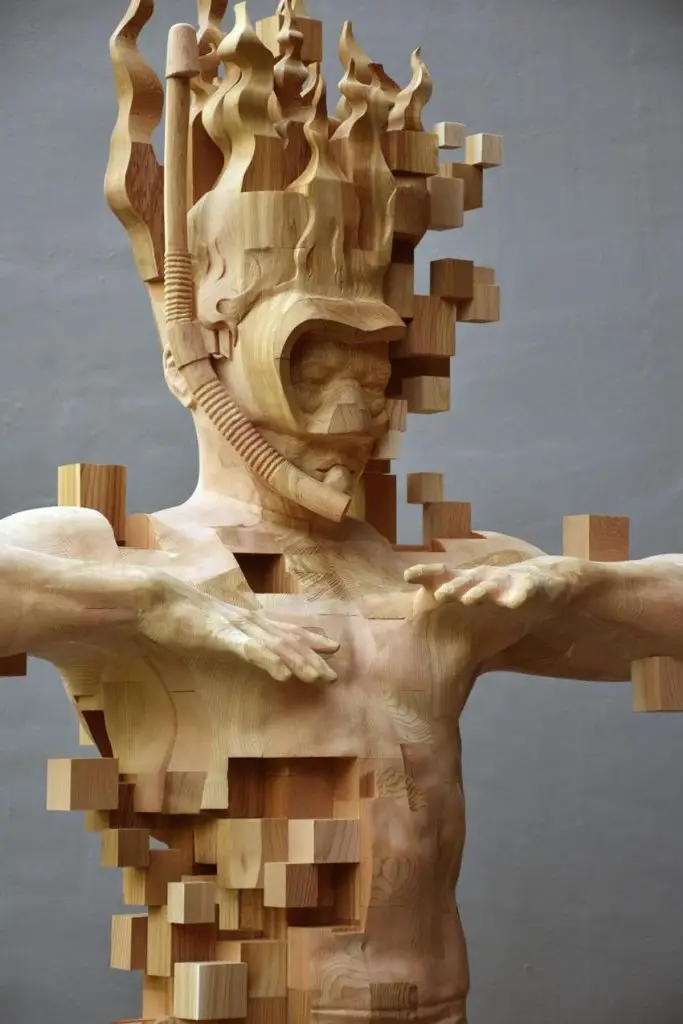
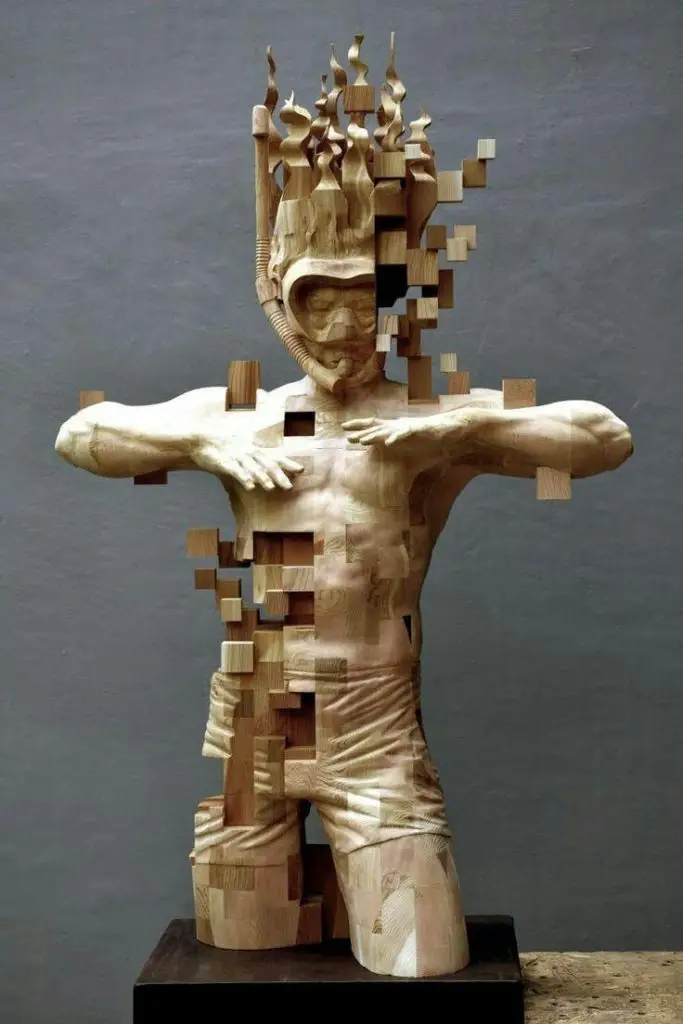
He is also able to achieve the submerged underwater look through the figure’s hair, which is wood carved to flow upward and dissolve into nothing.
It’s not often that elements as distinct as water and wood are linked so beautifully without the actual use of water. Han achieves this perfectly.
Other amazing artworks that feature either pixels or wood
In the case of pixels, Milan-based painter, Aldo Sergio uses paint to make warped images that create a link between the digital and physical world.
He uses traditional methods to paint images and then carefully places glitches in the form of pixels or blurs on them. This gives his artworks an unusual but interesting look that differs from the solid nature of traditional painting. [5]
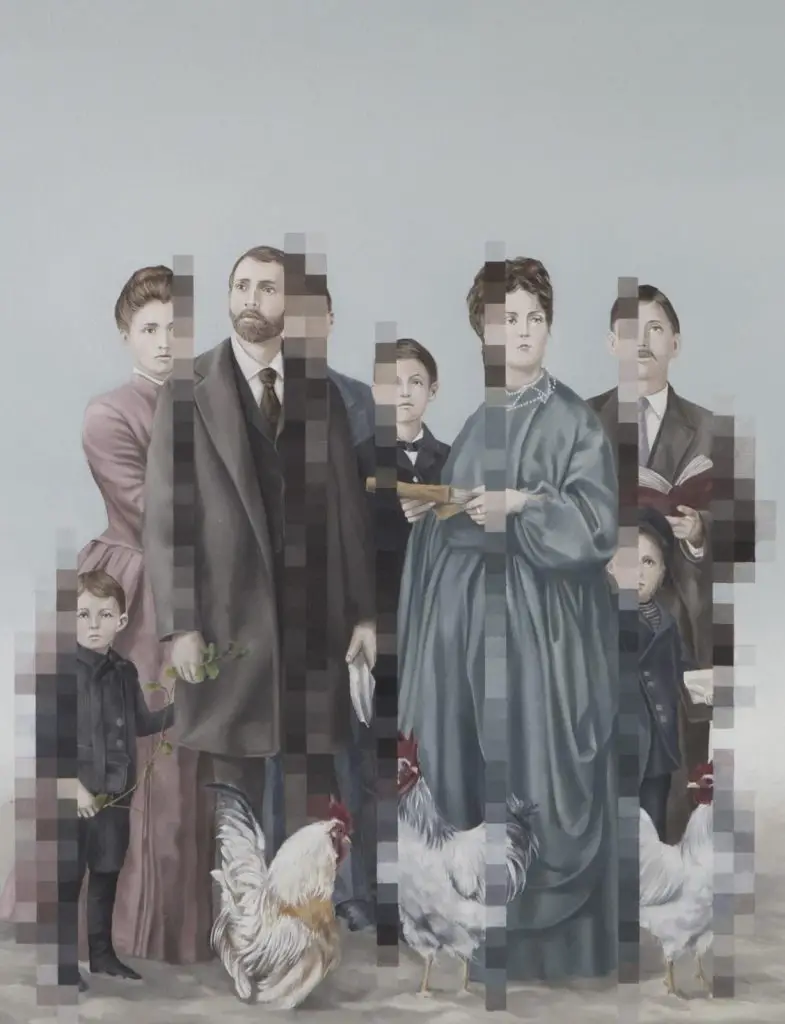
As for wood, artists like Han have used it in a way that transcends the very essence of itself. On that note is the “Good Vibrations” furniture by Ferrucio Laviani. Interestingly, this artist chooses to highlight the very glitch people are so critical of in this digital age. At first glance, you’d think it’s an image that is a result of faulty editing, but this is a piece of furniture carved intricately with every detail gotten down to a T. [6]
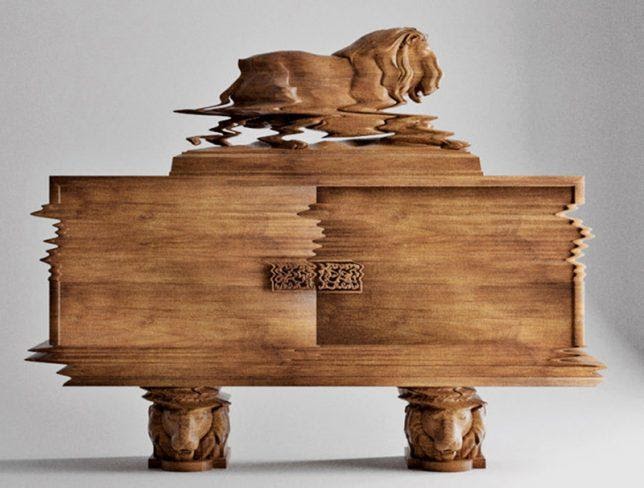
Artist Laviani collaborated with the manufacturer of Baroque furniture to create the cabinets. Laviani took an unconventional approach by programming computer-controlled robotic routers to cut glitches in the wood. That is how they were able to create the warped look.
The resulting series is known as “F**** THE CLASSICS!” which includes the “Good Vibrations” cabinet.
It’s simply amazing to witness the exceptional things people can come up with. These artists are simply talented beyond words and we cannot wait to see what else they can create.
References
- “Taiwanese Artist Hsu Tung Han, between human and technology.” Luxiders. Editor. Accessed January 23, 2020.
- “These Pixelated Sculptures That Look Like Computer Glitches Are Actually Made From Wood.” Bored Panda. Stella. Accessed January 23, 2020.
- “Pixel.” Britannica. Editor. Accessed January 23, 2020.
- “New Figurative Wooden Sculptures by Han Hsu-Tung Dissolve Into Pixelated Cubes.” Colossal. Kate Sierzputowski. October 24, 2018.
- “Painted Portraits of Victorian Families, Still Lifes, and Birds.” Colossal. Anna Marks. November 13, 2018.
- “Ferruccio Laviani’s ‘Good Vibrations’ Furniture Looks Like A Digital Illusion (PHOTOS).” HuffPost. Rain Embuscado . March 15, 2013.
